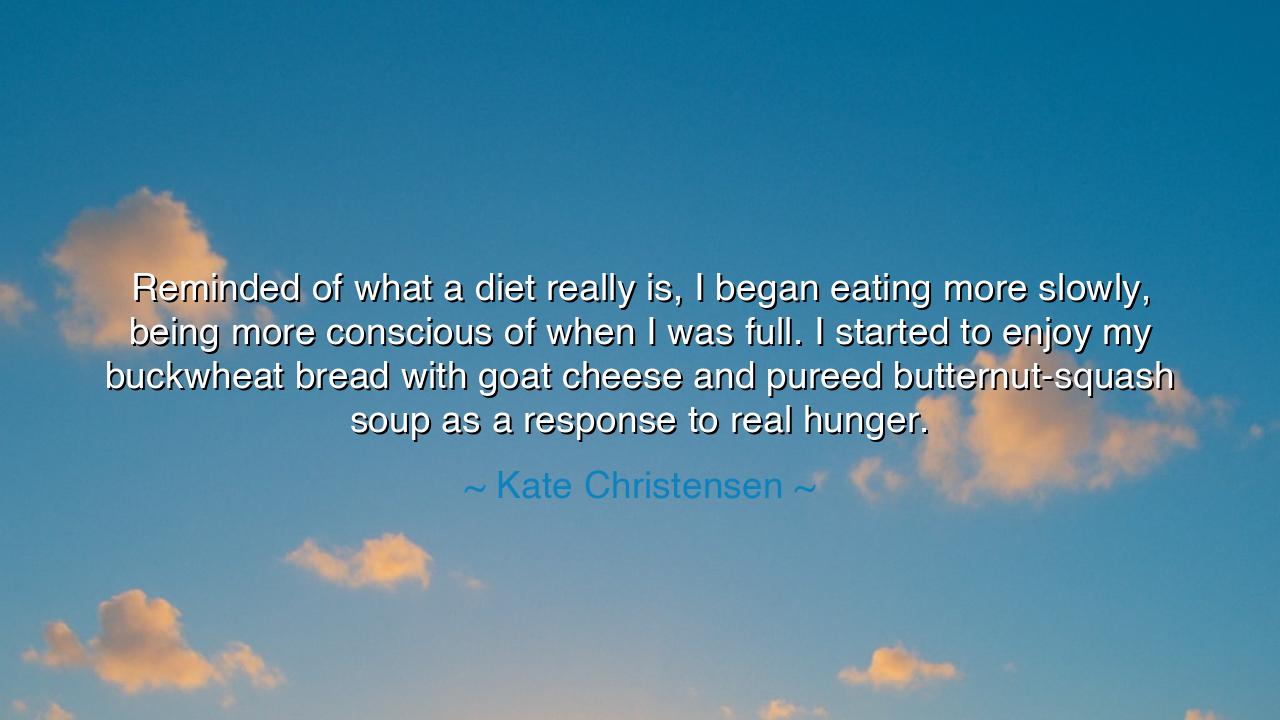
Reminded of what a diet really is, I began eating more slowly
Reminded of what a diet really is, I began eating more slowly, being more conscious of when I was full. I started to enjoy my buckwheat bread with goat cheese and pureed butternut-squash soup as a response to real hunger.






The words “Reminded of what a diet really is, I began eating more slowly, being more conscious of when I was full. I started to enjoy my buckwheat bread with goat cheese and pureed butternut-squash soup as a response to real hunger” by Kate Christensen are more than a reflection on food — they are a meditation on awareness, restraint, and presence. In a world that glorifies speed and excess, Christensen’s realization is an awakening — the rediscovery of harmony between body and spirit. Her words recall the wisdom of the ancients, who saw food not merely as sustenance, but as a sacred ritual, a dialogue between human need and nature’s abundance.
When she speaks of being “reminded of what a diet really is,” she returns to the original meaning of the word diet: not a punishment, not restriction, but a way of life. The Greeks called it “diaita,” a term that encompassed one’s entire manner of living — food, sleep, behavior, and thought. Christensen’s transformation echoes that ancient understanding. She moves beyond counting calories or chasing control; she seeks instead to live in rhythm with her own body. Her “diet” becomes a practice of consciousness, a return to balance after years of disconnection from the natural signals of hunger and satisfaction.
Her words “I began eating more slowly, being more conscious of when I was full” remind us that wisdom often lies not in doing more, but in slowing down. In her slowness, she finds gratitude. The act of eating becomes a meditation — each bite an act of presence, each flavor a moment of stillness in the noise of modern life. Ancient monks and philosophers knew this truth well. The Buddhist sage would chew in silence, honoring the grain of rice as if it were a jewel. The Stoic would give thanks before a simple meal, understanding that gratitude nourishes the soul as much as the body. Christensen, in her simplicity, joins that lineage of mindful living.
When she describes her “buckwheat bread with goat cheese and pureed butternut-squash soup,” she offers not luxury, but purity. There is poetry in her food — humble, natural, and whole. These are not foods of indulgence, but of intention. They reflect the kind of beauty that comes when nourishment is stripped of pretense. The ancients spoke of the golden mean — the virtue found between extremes. Christensen’s meal is that balance embodied: modest yet satisfying, deliberate yet joyful. It teaches that pleasure need not be extravagant; true joy is found when the senses and the soul move in harmony.
Her awakening also carries a deeper moral. She says she began to eat “as a response to real hunger” — not desire, not habit, but need. This is the essence of temperance, one of humanity’s oldest virtues. To respond only to what is real — to listen to the body’s whisper, not the mind’s craving — is to live in truth. The great philosopher Epicurus taught that pleasure was not the endless pursuit of taste, but the freedom from unnecessary want. “If you wish to make a man rich,” he said, “do not add to his possessions, but subtract from his desires.” Christensen’s rediscovery of hunger is thus a rediscovery of freedom — freedom from the tyranny of indulgence, from the noise that confuses appetite with emptiness.
Throughout history, those who have sought enlightenment have found it not in excess, but in awareness. The samurai, before battle, ate rice with calm focus; the poet, before writing, drank tea in silence. Each understood that how one eats reflects how one lives. Christensen’s journey mirrors this timeless truth: that the quality of one’s nourishment mirrors the quality of one’s consciousness. When she began to eat slowly, she was not only feeding her body — she was feeding her soul, teaching herself again how to live with attention, reverence, and gratitude.
So, dear listener, learn from her revelation: eat with awareness, not anxiety. Do not rush through your meals as though life itself were a race. Taste what you consume, honor what sustains you, and listen to your body as you would listen to a teacher. Do not eat to fill an emptiness of the heart, but to answer the honest call of need. For in the simple act of mindful nourishment lies the oldest and purest form of wisdom — the knowledge that peace is not found in plenty, but in presence. As Kate Christensen teaches, when we eat with consciousness, we do not merely feed ourselves — we awaken.






AAdministratorAdministrator
Welcome, honored guests. Please leave a comment, we will respond soon